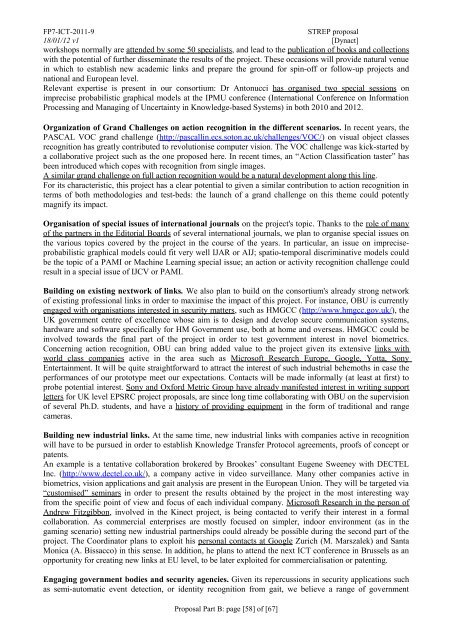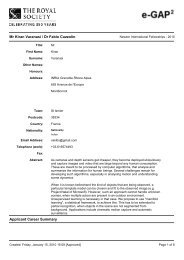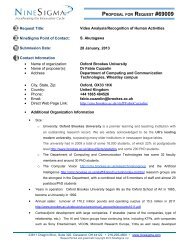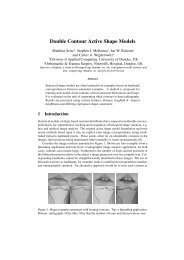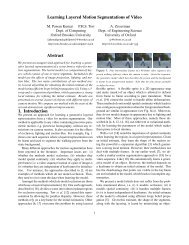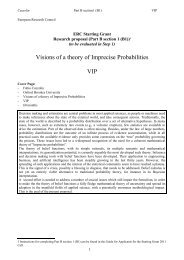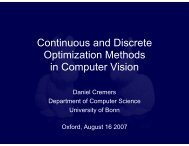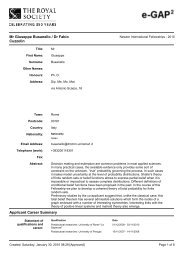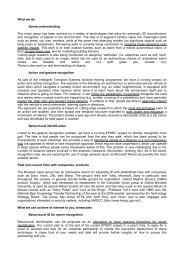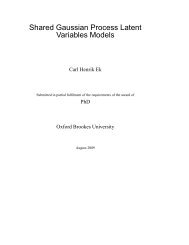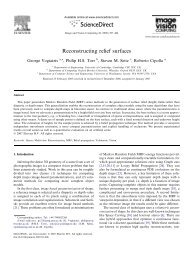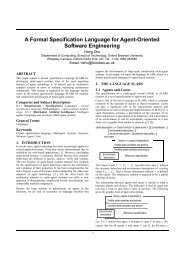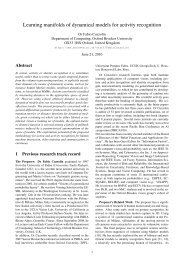Project Proposal (PDF) - Oxford Brookes University
Project Proposal (PDF) - Oxford Brookes University
Project Proposal (PDF) - Oxford Brookes University
Create successful ePaper yourself
Turn your PDF publications into a flip-book with our unique Google optimized e-Paper software.
FP7-ICT-2011-9 STREP proposal<br />
18/01/12 v1 [Dynact]<br />
workshops normally are attended by some 50 specialists, and lead to the publication of books and collections<br />
with the potential of further disseminate the results of the project. These occasions will provide natural venue<br />
in which to establish new academic links and prepare the ground for spin-off or follow-up projects and<br />
national and European level.<br />
Relevant expertise is present in our consortium: Dr Antonucci has organised two special sessions on<br />
imprecise probabilistic graphical models at the IPMU conference (International Conference on Information<br />
Processing and Managing of Uncertainty in Knowledge-based Systems) in both 2010 and 2012.<br />
Organization of Grand Challenges on action recognition in the different scenarios. In recent years, the<br />
PASCAL VOC grand challenge (http://pascallin.ecs.soton.ac.uk/challenges/VOC/) on visual object classes<br />
recognition has greatly contributed to revolutionise computer vision. The VOC challenge was kick-started by<br />
a collaborative project such as the one proposed here. In recent times, an “Action Classification taster” has<br />
been introduced which copes with recognition from single images.<br />
A similar grand challenge on full action recognition would be a natural development along this line.<br />
For its characteristic, this project has a clear potential to given a similar contribution to action recognition in<br />
terms of both methodologies and test-beds: the launch of a grand challenge on this theme could potently<br />
magnify its impact.<br />
Organisation of special issues of international journals on the project's topic. Thanks to the role of many<br />
of the partners in the Editorial Boards of several international journals, we plan to organise special issues on<br />
the various topics covered by the project in the course of the years. In particular, an issue on impreciseprobabilistic<br />
graphical models could fit very well IJAR or AIJ; spatio-temporal discriminative models could<br />
be the topic of a PAMI or Machine Learning special issue; an action or activity recognition challenge could<br />
result in a special issue of IJCV or PAMI.<br />
Building on existing nextwork of links. We also plan to build on the consortium's already strong network<br />
of existing professional links in order to maximise the impact of this project. For instance, OBU is currently<br />
engaged with organisations interested in security matters, such as HMGCC (http://www.hmgcc.gov.uk/), the<br />
UK government centre of excellence whose aim is to design and develop secure communication systems,<br />
hardware and software specifically for HM Government use, both at home and overseas. HMGCC could be<br />
involved towards the final part of the project in order to test government interest in novel biometrics.<br />
Concerning action recognition, OBU can bring added value to the project given its extensive links with<br />
world class companies active in the area such as Microsoft Research Europe, Google, Yotta, Sony<br />
Entertainment. It will be quite straightforward to attract the interest of such industrial behemoths in case the<br />
performances of our prototype meet our expectations. Contacts will be made informally (at least at first) to<br />
probe potential interest. Sony and <strong>Oxford</strong> Metric Group have already manifested interest in writing support<br />
letters for UK level EPSRC project proposals, are since long time collaborating with OBU on the supervision<br />
of several Ph.D. students, and have a history of providing equipment in the form of traditional and range<br />
cameras.<br />
Building new industrial links. At the same time, new industrial links with companies active in recognition<br />
will have to be pursued in order to establish Knowledge Transfer Protocol agreements, proofs of concept or<br />
patents.<br />
An example is a tentative collaboration brokered by <strong>Brookes</strong>’ consultant Eugene Sweeney with DECTEL<br />
Inc. (http://www.dectel.co.uk/), a company active in video surveillance. Many other companies active in<br />
biometrics, vision applications and gait analysis are present in the European Union. They will be targeted via<br />
“customised” seminars in order to present the results obtained by the project in the most interesting way<br />
from the specific point of view and focus of each individual company. Microsoft Research in the person of<br />
Andrew Fitzgibbon, involved in the Kinect project, is being contacted to verify their interest in a formal<br />
collaboration. As commercial enterprises are mostly focused on simpler, indoor environment (as in the<br />
gaming scenario) setting new industrial partnerships could already be possible during the second part of the<br />
project. The Coordinator plans to exploit his personal contacts at Google Zurich (M. Marszalek) and Santa<br />
Monica (A. Bissacco) in this sense. In addition, he plans to attend the next ICT conference in Brussels as an<br />
opportunity for creating new links at EU level, to be later exploited for commercialisation or patenting.<br />
Engaging government bodies and security agencies. Given its repercussions in security applications such<br />
as semi-automatic event detection, or identity recognition from gait, we believe a range of government<br />
<strong>Proposal</strong> Part B: page [58] of [67]


